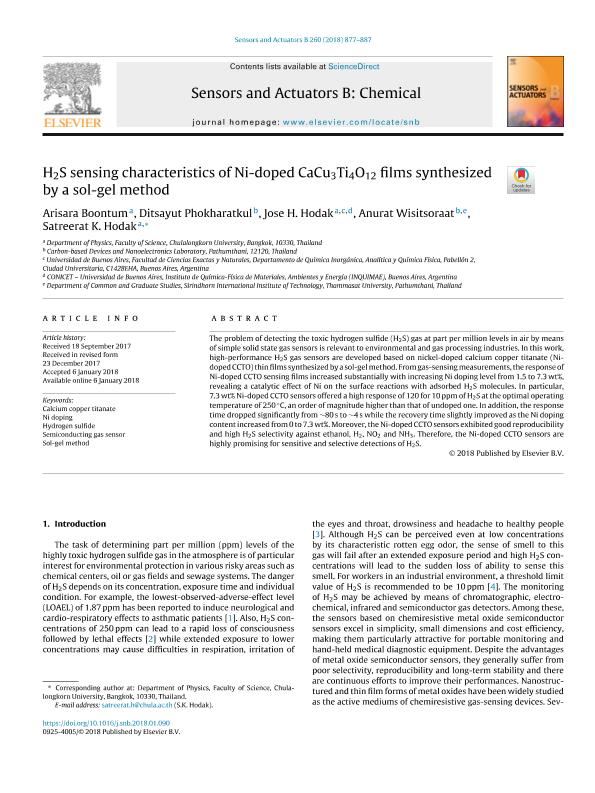Mostrar el registro sencillo del ítem
dc.contributor.author
Boontum, Arisara
dc.contributor.author
Phokharatkul, Ditsayut
dc.contributor.author
Hodak, Jose Hector

dc.contributor.author
Wisitsoraat, Anurat
dc.contributor.author
Hodak, Satreerat K.
dc.date.available
2019-11-12T17:41:15Z
dc.date.issued
2018-05
dc.identifier.citation
Boontum, Arisara; Phokharatkul, Ditsayut; Hodak, Jose Hector; Wisitsoraat, Anurat; Hodak, Satreerat K.; H2S sensing characteristics of Ni-doped CaCu3Ti4O12 films synthesized by a sol-gel method; Elsevier Science Sa; Sensors and Actuators B: Chemical; 260; 5-2018; 877-887
dc.identifier.issn
0925-4005
dc.identifier.uri
http://hdl.handle.net/11336/88648
dc.description.abstract
The problem of detecting the toxic hydrogen sulfide (H2S) gas at part per million levels in air by means of simple solid state gas sensors is relevant to environmental and gas processing industries. In this work, high-performance H2S gas sensors are developed based on nickel-doped calcium copper titanate (Ni-doped CCTO) thin films synthesized by a sol-gel method. From gas-sensing measurements, the response of Ni-doped CCTO sensing films increased substantially with increasing Ni doping level from 1.5 to 7.3 wt%, revealing a catalytic effect of Ni on the surface reactions with adsorbed H2S molecules. In particular, 7.3 wt% Ni-doped CCTO sensors offered a high response of 120 for 10 ppm of H2S at the optimal operating temperature of 250 °C, an order of magnitude higher than that of undoped one. In addition, the response time dropped significantly from ∼80 s to ∼4 s while the recovery time slightly improved as the Ni doping content increased from 0 to 7.3 wt%. Moreover, the Ni-doped CCTO sensors exhibited good reproducibility and high H2S selectivity against ethanol, H2, NO2 and NH3. Therefore, the Ni-doped CCTO sensors are highly promising for sensitive and selective detections of H2S.
dc.format
application/pdf
dc.language.iso
eng
dc.publisher
Elsevier Science Sa

dc.rights
info:eu-repo/semantics/openAccess
dc.rights.uri
https://creativecommons.org/licenses/by-nc-sa/2.5/ar/
dc.subject
CALCIUM COPPER TITANATE
dc.subject
HYDROGEN SULFIDE
dc.subject
NI DOPING
dc.subject
SEMICONDUCTING GAS SENSOR
dc.subject
SOL-GEL METHOD
dc.subject.classification
Química Analítica

dc.subject.classification
Ciencias Químicas

dc.subject.classification
CIENCIAS NATURALES Y EXACTAS

dc.title
H2S sensing characteristics of Ni-doped CaCu3Ti4O12 films synthesized by a sol-gel method
dc.type
info:eu-repo/semantics/article
dc.type
info:ar-repo/semantics/artículo
dc.type
info:eu-repo/semantics/publishedVersion
dc.date.updated
2019-10-16T15:25:07Z
dc.journal.volume
260
dc.journal.pagination
877-887
dc.journal.pais
Países Bajos

dc.journal.ciudad
Amsterdam
dc.description.fil
Fil: Boontum, Arisara. Chulalongkorn University
; Tailandia
dc.description.fil
Fil: Phokharatkul, Ditsayut. Carbon-based Devices And Nanoelectronics Laboratory; Tailandia
dc.description.fil
Fil: Hodak, Jose Hector. Chulalongkorn University
; Tailandia. Consejo Nacional de Investigaciones Científicas y Técnicas. Oficina de Coordinación Administrativa Ciudad Universitaria. Instituto de Química, Física de los Materiales, Medioambiente y Energía. Universidad de Buenos Aires. Facultad de Ciencias Exactas y Naturales. Instituto de Química, Física de los Materiales, Medioambiente y Energía; Argentina. Universidad de Buenos Aires. Facultad de Ciencias Exactas y Naturales. Departamento de Química Inorgánica, Analítica y Química Física; Argentina
dc.description.fil
Fil: Wisitsoraat, Anurat. B Carbon-based Devices And Nanoelectronics Laboratory; Tailandia. Thammasat University; Tailandia
dc.description.fil
Fil: Hodak, Satreerat K.. Chulalongkorn University
; Tailandia
dc.journal.title
Sensors and Actuators B: Chemical

dc.relation.alternativeid
info:eu-repo/semantics/altIdentifier/url/https://www.sciencedirect.com/science/article/pii/S092540051830090X
dc.relation.alternativeid
info:eu-repo/semantics/altIdentifier/doi/http://dx.doi.org/10.1016/j.snb.2018.01.090
Archivos asociados
